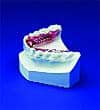by Charlene N. White
Are you controlling your inventory or is it controlling you?
 |
| Charlene N. White |
An orthodontist attends a practice-management seminar and compares his profit and loss statement to other attendees’ statements. He is shocked to see that his clinical inventory costs were 11% of his gross collections last year. The average for the group attending was 7.8%, and some were as low as 5.5%! What was he not doing? (For comparison’s sake, 11% of a $1.4-million practice is $154,000, while 7.8% would be $109,200. That is a difference of $44,800.)
Not only was this orthodontist spending more money than average, his staff was often frustrated by going to get a supply that was not on the shelf. He was determined to get some answers. Normally, this is how the orthodontist realizes that he needs to focus on inventory control or it can mean a loss of thousands of dollars per year. I have consulted with hundreds of orthodontic practices in 25 years. In many cases, the inventory costs were too high, not because of using quality products, but due to a faulty system in this area. In this article, I will outline how to attack this important part of your practice.
Creating the System
I have found that the success of an effective inventory system begins with the inventory control coordinator. It is important for a coordinator to be a thrifty shopper. Staff members who are thrifty shoppers do a great job for the practice. They must also be organized, accurate record keepers who are assertive, detailed oriented, and able to negotiate. However, it is important to realize that controlling inventory costs in the practice is a team effort. Believe it or not, some offices drop literally thousands of dollars’ worth of supplies on the floor each year.
The first step is to take a physical inventory of all the clinical supplies in the office. Record the names of the products, and make a list of how many of each item are currently in stock. Gather up all items that you no longer use in the office. Make sure you get old, unused inventory off the shelves and out of the drawers. Once you have collected all the unused inventory, check to see if any of it can be turned in for credit. If not, you may want to discard it if you are unable to donate it
Evaluate how well organized your supply area is at this time. You may have the luxury of having a nice, open walk-in closet with open shelves, which is the ideal way for storing clinical supplies. Some of you may have to keep supplies in drawers and cabinets throughout the office. Assess your situation, and organize the supplies in the best possible manner. If you have open shelves to store your supplies on, purchase bins from your dental supplier to keep items together on the shelf in an organized manner.
The entire staff should be informed where to find various supplies. In organizing your inventory system, label and record where supplies are located in the office. Label drawers or shelves with a numbering system that correlates back to a log that all staff members can easily access. It is frustrating for staff members to have to constantly come to the inventory control coordinator to find out where a supply is located. This information should be readily available to the team.
 |
The next step is to set all reorder points and determine how much of the supply you want to keep in the office at any given time. It is important to be adequately stocked but not overstocked on items. You will need to know approximately how long it takes to receive an item so you can set your reorder points to avoid ordering items at the last minute and paying top prices.
The reorder point tags should be placed directly at the reorder point. When a staff member takes a particular supply item off the shelf and the reorder tag is attached, he or she should remove the tag. This reorder tag should be placed in a bin or a file specifically designed for the inventory coordinator. This creates a communication system between the clinical team and the inventory control coordinator.
The next thing you will need to do in setting up your system is to complete the inventory log. This can be placed in a notebook or into a computerized system. Make a list of the companies that you normally use and what items you order from each company. In fact, make two lists: one categorized by company and another categorized by item.
Once you have your physical inventory done, logs completed, reorder tags placed, and a plan for advising the staff of the location of supplies, schedule a staff meeting to go over all the details with everyone on the team. It is not effective for staff members to hear things through the grapevine. They will appreciate being educated and informed as to how the system works.
Inform the team that an annual budget for clinical supplies has been determined. Let them know that this is going to be a team effort. The goal is to be efficient and take excellent care of the patients, but also not to waste the clinical supplies. For example, you need to have a specific measuring system in using your bond and band adhesives. Without a measuring system, a lot of expensive product can be left on the pad. Staff members need to be informed as to how much the expensive items cost. Many staff members do not realize that some of these items cost several hundred dollars. Teach them how not to waste products and also the impact that that waste has on the practice. Keep the team informed monthly of where you stand regarding the budget. Keeping them informed keeps them involved.
Establishing a Budget
The next thing that you will need to do is to empower the inventory control coordinator with a budget. It is amazing what happens when you give a frugal shopper an annual budget to shoot for. I have often been astonished at how dramatically budget empowerment affects the expenditures in a practice.
8 Steps to Building an
Inventory-Control System
Step One: Appoint a frugal, detail-oriented inventory coordinator and a backup coordinator to cover when she is out. Take your physical inventory.
Step Two: Eliminate supplies that you are no longer using.
Step Three: Organize the location of the supplies, and create a chart for the staff to use.
Step Four: Organize the supplies on the shelves with bins as needed.
Step Five: Tag your reorder points for all supplies. Select a specific place to put the tags for reorder.
Step Six: Complete your inventory logs according to company and also according to supply.
Step Seven: Record your projected annual budget on your first order log. Subtract from the budget as you order.
Step Eight: Conduct a meeting with the entire clinical team to discuss the details of the system and the role that they can play in making it a success.
The percentages I recommend are based upon collections. When you look at your profit and loss statement, you should see orthodontic supply costs at approximately 6% to 8% of collections, and business supplies at approximately 2% of collections. The chart below shows actual numbers from orthodontic practices.
Based on 15 practices I’ve worked with recently (with average collections of $1,444,410 per year and 385 full and partial starts per year), clinical supplies cost an average of 8.8% of collections, while office supplies were an average of 1.6% of collections.
To set your budget for next year, you need to look at your production and your profit and loss statement from this year. What you produce this year projects what you will collect next year. In a growing practice, production can be ahead of collections. If you collected $600,000 this year but produced $800,000, then you will probably collect close to $800,000 next year. Your budget for inventory should be based on the previous year’s percentage and the total production totals.
Clinical supplies do not include instruments and equipment. They also do not include marketing items such as T-shirts. Those items should be listed under a marketing category. Lab fees that you pay to companies like OrthoCAD, Invisalign, and SureSmile should also be in a separate category.
Now let’s talk about some things that could potentially affect your budget amounts. For example, if you are planning to change your band and bracket system during the coming year, you need to add 2% to your budget amount. If you plan to purchase stationery and have a new logo designed, you will want to increase your business supply costs by 2%. These items will vary practice to practice. You just need to be realistic about your costs when you are setting up your budget.
You also need to consider how flexible you can be with comparison-shopping. Some orthodontists only want to use specific products and are not willing, for example, to order elastics from another company. If you have specific guidelines about a lot of products that you would like to order, you need to build this into your budget. A 6% clinical supply budget may not be realistic for your practice; you may need to increase yours to 7% or 8%.
Making Time to Order
Once your budget goals are set, your inventory coordinator needs to have nonpatient time to work on the inventory. Quite often, not having the time to order is the key problem in the inventory system. For example, a practice that is producing approximately $500,000 per year needs approximately 1 to 2 hours per week to order inventory. A practice that is producing $1,000,000 per year will need approximately 2 to 4 hours per week. Larger practices may need as much as 6 hours per week to dedicate to inventory control.
Inventory costs skyrocket when a staff member has no allocated nonpatient time to do the ordering and to focus on comparison-shopping. What happens in these offices is the staff member runs back to the lab when she gets a break between patients, picks up the phone, calls the company, and says, “Send us the item as quickly as possible—we are almost out.” There is no discussion of price, and you can be sure you will be paying the highest shipping cost. In practices like this, I see expenditures of well over 10% to 12% of collections due to the fact that no one has been empowered with a budget and no one has the nonpatient time weekly to focus on the inventory control. It is the orthodontist’s job to make sure that the time has been allocated for the inventory control coordinator to perform at a high level.
As we all know, praise and appreciation lead to top performance. It is important for the orthodontist to give the inventory control coordinator feedback on how well he or she is doing. If you have a staff member who does a great job of implementing this system, a surprise bonus would definitely be in order. You should also consider giving her an increase in salary in her performance review. A staff member who implements this system and saves the practice money needs to be rewarded.
Placing the Order
The first thing you want to do before you place your order is to see where the best price is being offered. If there are better prices offered through other companies than the one you usually deal with, you can use this information in negotiating the best price with the sales representative. Once you have done your comparison-shopping, place the call to the vendor and have your order log in front of you. Record the date that the order was placed, the item that you ordered, the item code, the amount you ordered, and the name of the vendor. Make sure you get the name of the person who is receiving the order. Record the method of payment if you are placing the order, for example, on a credit card over the phone. Confirm the price of the item, and record the price in your log. When the order is received, the “quoted price” should go onto the packing slip. The bookkeeper should check the quoted price against the actual charge.
If you have seen the item at a better price through another company, ask the salesperson if his or her company can match the price. You may also want to ask for a 2% discount if you guarantee payment within 10 days of placing the order. Let the salesperson know that you are on a budget and that you need the best price they can give you. The best shoppers get the best prices. If you do not ask for a better price, you are not going to obtain one. Once you have effectively negotiated with the salesperson, record your quoted total price on your order log.
Receiving the Order
The inventory-control coordinator should be the only person to open and stock the supplies that the practice receives. If someone is helping with this, it is important to train him or her how to properly stock the items and also to have a specific place that they place the packing slip to confirm that the order has been received.
When the supply is received, open the box and remove the packing slip. Review the contents and make sure all of the supplies are received as ordered. Also, make sure nothing is damaged or needs to be returned. Go to the order log and record the date received. It is important to know the order date and the date received so you can continue to fine-tune the reorder points for various supplies. Stock the supply in its proper place, and return the reorder tag to the appropriate spot on the specific item. If the item is back-ordered, make a notation and recheck the date of delivery. Record the quoted price on the packing slip. This is an extremely important step, because the person paying the bills needs to be able to verify that the quoted price is what is listed on the invoice.
Other Inventory Tips
Some offices work with a local sales representative who comes in and actually reviews the inventory for them and resupplies the office on a regular basis. Naturally, this makes it much easier for the inventory coordinator; however, you will typically pay 2% to 3% more for this service. Quite often I find that high inventory costs are coming from the local dental supplier rather than from the orthodontic supply companies. When you get caught in a rut where you think it’s easier just to place the order and not comparison shop, your supply costs always increase.
Sometimes, buying in bulk can be advantageous. However, you need to be cautious in doing this when buying products that have a shelf life. Before you buy something in bulk, calculate the savings to make sure that it is going to be an advantage to the practice. You also need to consider whether or not you have the space to store the inventory. Many offices benefit from having a large basement area where they can store supplies like gloves and patient towels. Sometimes you are able to buy these types of items at a reduced cost when specials are advertised. If you place a bulk order, try to negotiate a payment plan over a 6-month period of time—paying over time can be better for the cash flow of the practice.
Also, doing lots of repairs and having a large number of patients who are past their deband target date will create higher costs for the supply budget.
Another area that the coordinator needs to be aware of is when companies offer across-the-board discounts. Quite often when you have been offered a package discount, the coordinator will start to assume that this must be the best price. Make sure you continue to compare prices and ask for the best price from your sales representative. The person paying the bills will also need to check the invoices to make sure that the discounts have been given as promised.
The inventory control coordinator typically has salespeople calling or visiting the practice. It is frustrating to the rest of the clinical team for the inventory-control coordinator to leave the clinical area during patient time to talk to sales representatives. It would be great if you could set up a voicemail box or return calls to salespeople when patients are not being seen. Efficient salespeople should be able to work around your schedule and call you during your designated inventory-control time.
| To read more articles by Charlene N. White, search for in our free online archives. |
The inventory-control coordinator should also encourage each person on the clinical team to stock his or her unit each day. It is much more efficient for each unit to be stocked so that assistants are able to stay with their patients. Stocking the units once per day at a designated time adds to the efficiency in the patient flow. Make sure that new staff members are informed of how to stock their units.
Another area to look at in placing your orders is packaging. Individually packaged items typically cost much more. You would be amazed at the hundred to thousands of dollars you could save per year by looking at packaging. On nonpatient days or when the orthodontist goes out of town, the clinical team often looks for jobs that need to be done in the office. Taking a box of alginate and dispensing it into Ziploc® bags for daily use could be one of the duties that the clinical team does on non-patient days.
Computerized systems are available to the orthodontic practice. You may choose to use an automated system. However, the inventory coordinator must be trained to order effectively and efficiently. Choosing the right inventory coordinator, setting a budget, and allocating the time to order are keys to a successful plan.
In addition to managing a full schedule of speaking engagements in the United States, Canada, and abroad, Charlene N. White has authored 18 training products, a quarterly newsletter, and numerous articles published in dental journals. She has been a dedicated supporter of the AAO, serving as a lay director on the AAO Foundation Board. She can be reached at










